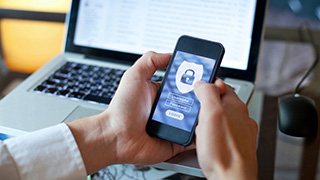Protect Your Digital Life: Essential Tips for Device Security
Thursday, October 24, 2024
 In today’s digital age, mobile devices are essential tools for both personal and professional
use. They facilitate communication, store sensitive information and enable seamless
access to work and academic resources. However, this convenience comes with increased
risks, making these devices prime targets for thefts and cyberattacks.
In today’s digital age, mobile devices are essential tools for both personal and professional
use. They facilitate communication, store sensitive information and enable seamless
access to work and academic resources. However, this convenience comes with increased
risks, making these devices prime targets for thefts and cyberattacks.
As we enter Week 4 of Cybersecurity Awareness Month, the Department of Information Technology has compiled a list of key tips to help secure your devices from potential threats:
-
Record your device's serial number: One simple yet effective security measure is recording your device’s model name and serial number. Take pictures or screenshots of these details—usually found under "About Phone" in your settings—and email them to yourself. Having this information readily available can be crucial if your device is stolen, aiding both law enforcement and insurance claims.
-
Enable location-finding services: Applications like Find My iPhone (iOS) or Find My Device (Android) can help locate a lost or stolen device. These tools also allow you to remotely lock or erase your device, preventing unauthorized use.
-
Avoid insecure wireless networks: While convenient, connecting to public or unsecured Wi-Fi networks can expose your device to hacking. Only use trusted, secure networks to protect your information from potential threats.
-
Use strong passwords or biometric locks: Secure your device with strong passwords or biometric features like fingerprint or facial recognition. This simple step prevents unwanted access and adds an essential layer of protection to your data.
-
Back up your data: Regularly backing up your data ensures you don’t lose important files due to theft or technical issues. Utilize OneDrive for Business to keep your documents, photos, and research safe.
-
Do not leave devices unattended: Always use a cable and lock when leaving your laptop unattended, avoid leaving it visible in a car and refrain from leaving it unattended in public spaces on seats, tables or floors. These safety measures significantly reduce the risk of unauthorized access or theft.
-
Conduct regular updates: Regularly updating your device’s software ensures you have the latest security patches to protect against potential threats. You can follow Seton Hall's guide on Windows, Microsoft, and Lenovo system updates to keep your devices secure.
-
Install antivirus software: Protect your device by installing reliable antivirus software to detect and prevent malware or malicious attacks. Regularly update the software to ensure it can counter the latest threats.
-
Check the source before downloading: Install apps only from trusted sources with positive reviews. Avoid downloading updates or applications on public networks (e.g., airports, cafes, hotels) since malicious actors may pose as legitimate access points and deliver malware disguised as genuine updates.
In the event of a lost or stolen laptop:
Notify Local Authorities:
- Report the incident to Seton Hall University's Public Safety Office (South Orange or IHS Campus) within 48 hours of loss or theft.
- If the device was lost or stolen off-campus, you must also notify the local police department and file a report with them.
In both cases, ensure that reports are filed with the respective offices.
Notify Asset Management:
- Inform the Asset Management Office in Corrigan Hall, Room 27, by calling (973) 313-6181 or via email if your SHU-issued device has been lost or stolen.
- Bring copies of the reports from Public Safety and, if applicable, the local police to the Asset Management Office in order to initiate the process of receiving a replacement laptop.
Categories: Science and Technology





